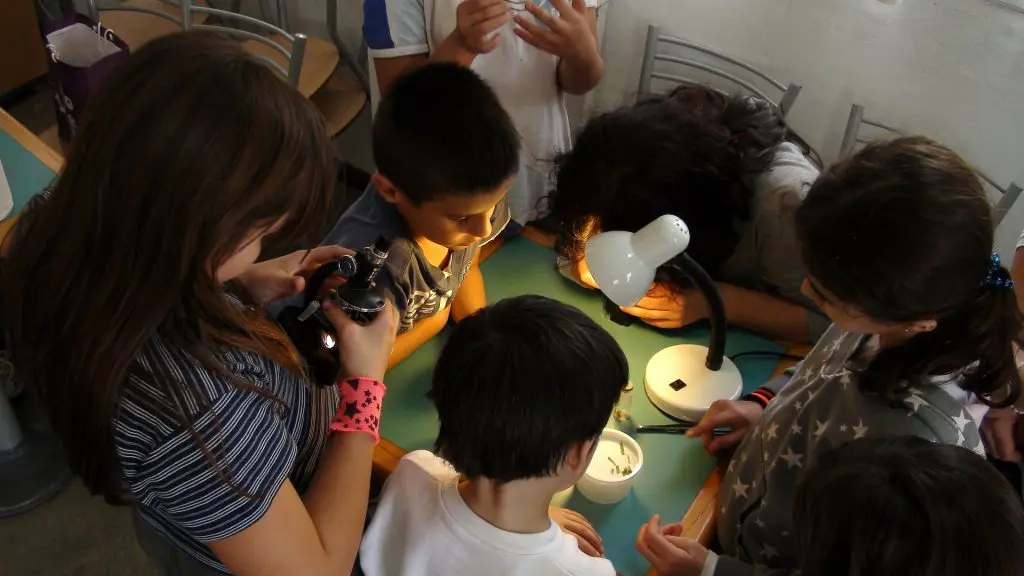If you’re on this page, perhaps you’re here to inquire about a new style of learning. Maybe you’ve heard of inquiry learning in class — be that a class you’re taking as a student, or one you took en route to becoming a teacher. We’re here to explain inquiry learning to learners and educators, and show how both can use it to their best advantage.
What the Heck is Inquiry Based Learning?
To begin, what is inquiry based learning? Inquiry based learning is, as the name suggests, a style of learning that develops inquiry skills and ignites curiosity in students. While there are different types of inquiry based learning, the common denominator among them is simply that, instead of following a cut-and-dry lesson plan, educators inspire students to come up with their own questions, spark curiosity, and then discover their own answers.
What Does Inquiry Based Learning Mainly Focus On?
We are used to thinking of school as a place where we sit down, hold a pen or pencil, and zone out — or else focus on the exquisite mold patterns in the ceiling, the dirt in the grout of cracked tiles, and the loose thread on the back collar of the person sitting in front. We take tests, write essays, and, theoretically, might come out of it learning something.
Of course that’s not what school is really about, and inquiry based learning attempts to shake up the supposed monotony of memorization and studying. Inquiry based learning puts the learning in the hands of the students, and it’s more than just teaching the concept at hand — inquiry based learning teaches students how to learn.
Alright, that’s a great phrase– what does it mean?
Here’s how:
Inquiry-based learning encourages students to do their own research and come up with their own findings, all guided by an instructor. This is useful for college and higher-level research, as well as virtually any situation in the real world. Adults turn to Google when they want to know something, but even then, a few research skills — knowing which websites to trust, for one, and how to order information from different sources — definitely come in handy.
What are the Main Inquiry Methods?
Okay, but what does an ‘invent questions, find answers!’ model actually look like? The key here is student-driven. While the educator is, of course, pulling the strings, inquiry-based learning places responsibility on the student to drive their own learning. A common structure is this:
First, the educator introduces a general topic or theme. This can be general, such as the Industrial Revolution, or our Solar System, or it can be more specific. Using the example of the Industrial Revolution, the educator most likely explains how the Industrial Revolution began, and what changes it made to the individual workers of the day. Then, the educator encourages the students to ask questions, honing in on specific parts of this vast, sprawling topic.
Students spitball questions until there are enough that at least one or two questions really spoke to each student — we’re talking questions that lend themselves to research, rather than clean-cut, yes or no answers. Think ‘how did the Industrial Revolution affect Irish immigration into England?’ (Hint: the answer is complicated).
Instead of giving long, detailed answers to each question, the educator uses a system to have students, or groups of students, choose questions to research for themselves.
Second, students do research, generally during class time. Here the role of the educator is vital: the educator shows students how to research using trustworthy sources, including web content, but also via libraries and textbooks.
Third, we all learn best by teaching, and it’s best to have an end goal with all this research ahead of you. Thus, at the culmination of the research, students present their findings to the class. Generally this is confined to quick presentations which take up only one or two days of class. Rubrics are commonly used and distributed ahead of time, so that students know what points to hit, and which concepts, such as content, preparation, or presentation, they will be graded on.
Fourth (and finally), students reflect on their process. What worked, what didn’t, and why? This is key for developing students’ responsibility for their own learning. For instance, if a presentation was poorly delivered, the reflection aspect forces a student to confront whatever caused a poor performance — could the student have worked harder? Or was there an issue in the group dynamic that prevented a group from performing well? — rather than dismissing it as a bad grade and moving on.
These simple steps can undergo many sorts of variation, depending on the needs of the class. However, the key concepts — questions generated or influenced by the students, self-driven research, presentation, and reflection — are generally the same.
What are 9 Main Benefits of Inquiry Learning?
There are boundless inquiry based learning benefits, but we’ll limit it to nine, because we know you’ve got limited time:
1. Enhanced curiosity. Encouraging students to ask their own questions ignites a curiosity that is usually stifled. It’s hard to feel curious when you’re already overloaded with information. By freeing students to ask their own questions, we allow students to find that they actually have quite a few questions inside.
2. Dedicated interest. Because students design their research projects themselves, there is bound to be more student interest than there would be were the topics and questions arbitrarily assigned.
3. Developed research skills. A key component of inquiry based learning is that students do research on their own, so they learn valuable research skills which can be put to use for the rest of their academic and adult lives.
4. Team-building. Inquiry based learning frequently requires group work, which builds necessary team-working skills.
5. Time management. Because inquiry based learning is generally self-driven, with guidelines given by the teacher, students are responbsible for managing their day-to-day tasks, which builds necessary time management skills.
6. Presentation preparation. Students must present their findings at the end, so they are tasked with designing and scripting their own presentation. This builds valuable skills for future presentations, whether it be a science fair project a year or so down the road, or the presentation of research findings for professional study.
7. Public speaking skills. With presenting comes public speaking, so students can begin to develop their own, unique public speaking voices.
8. Reflection and responsibility. Students reflect on their process at the culmination of a project, which teaches not only reflection, but builds personal responsibility, as students are called upon to account for their successes and failures.
9. Stronger takeaway. At the end of the day, students are more likely to remember a project they developed, designed, and pursued on their own initiative. Months or years down the line, that inquiry will imprint on the students’ minds more than the routine projects handed out by instructors.
Is Inquiry Learning Better or More Effective Than Other Methods?
So we’ve discussed the benefits of inquiry learning — but it isn’t the end-all, be-all best thing. There are distinct advantages and disadvantages of inquiry based learning. Let’s go through some of the latter:
Inquiry-based learning is great to hone in on a specific topic or example, but it doesn’t impart a large swathe of facts. For example, a world history class based purely on student-driven projects about distinct events or countries would generally not give students a good overview of the development of civilization over the last two thousand years. Sometimes, a little lecture can go a long way.
Similarly, a math class made up of only projects will go much, much slower than having a teacher explain obstruse concepts, then assign practice problems and homework to hammer that knowledge in.
In both of these cases, as well as many others, the key is not to depend fully on inquiry learning, but to strike a healthy balance between inquiry based learning and traditional lecture-based instruction. A lecture-based history class with a few student projects to highlight certain events would be more interesting and varied than a class that is only lecture, but it would also impart more knowledge than a class of only projects.
9 Inquiry Based Learning Activities and Examples for Teachers
Wondering how to incorporate inquiry learning activities in to a traditional class? Never fear! Here are some basic guidelines to small-group or individual inquiry projects for any subject. Some of these could be assigned as homework; all can be confined to a few class periods, and some can be stretched over a few weeks, depending on your schedule.
1. Physics: Solar system model. There are a lot of angles from which to consider our solar system, and a lot of good, solid research to draw from. In an elementary, middle school, or lower-level high school classes, assign students to groups and have them research and/or calculate the orbits of different planets. For higher-level classes, lead an examination of Kepler’s Laws of Planetary Motion. Perhaps you can provide raw data and help students prove one of Kepler’s Laws.
2. Environmental studies: Modern issues. This one is pretty straightforward, since there are so many climate-threatening issues today. In any environmental studies class, give a project for students to investigate a specific issue, using analysis methods previously taught in class. This one can be pursued individually or in groups.
3. Geology: Rock analysis. Go on a field trip! Have students or groups each choose a rock from a nearby park, field, or canyon. Then, using either lab equipment or the infinite bounds of the internet, have students identify their rocks and build presentations around the formation and history of their rocks.
4. Biology: Leaf studies. Students love field trips — if not just to get out of class. Similarly to the previous example, have students choose leaves or other plant material to identify, using guide books and skills learned in class. Next, have them present on one aspect of said plant — the evolution of the plant from prehistoric times, the photosynthesis process of that particular plant, or how the plant has adapted to the invasive homo sapien species.
5. Chemistry: Elements of Industry. Chemistry is one of those classes which, by necessity, is largely lecture-based. However, students with a good background from class could conduct internet and/or library research on how a particular element or molecule is used in industry, with breakdowns and explanations of the exact reactions.
6. Language: Cultural study. It’s quite popular with language classes to divide students into pairs or groups and have them study one geographical, historical, or especially cultural aspect of the region in which the language is spoken. Bonus points for requiring a written and spoken presentation — both in the other language!
7. Economics: Models applied to life. Economics is all about learning models, and lecture is usually filled with modern examples. Take it a step further by assigning students to investigate a trend of their choosing, using models learned in class.
8. Art history: Specific art. Art history classes generally cover the development and innovations in art over a long period of time. Pepper in specific examples by having students choose artworks from a specific period, then research the artist, cultural context, and unique background of that specific art piece. There are some pretty wild stories in history, so this should be fun!
9. History: Artifact study. Remember what we said about field trips? Take your students to a local museum! Then, have each group choose an artifact to research — what was the cultural context behind said artifact? What do the representations of various figures mean? The list goes on, as history is rich and multi-faceted (plus, if there is no museum in easy access, the internet is full of information on various artifacts as well).
Wrapping Things Up: Key Takeaways on Inquiry Learning
Hopefully you feel pretty confident handling inquiry based learning — although not as confident as you will be once you’ve tried to implement it yourself! Remember, inquiry learning is all about structured inquiry, with educators guiding students onto the right path rather than pulling them along. There is no one ‘right way’ — it’s all about having freedom to do what works for you!
The four key aspects of inquiry learning are: to incite curiosity, to pursue research, to present findings, and to reflect. All four of these give the student the freedom to find his or her own answers, as well as the responsibility to account for achievement or faults. The focus of inquiry learning is not solely on what is learned, but also includes the process of learning, as well as the skills gained by doing research, creating presentations, and finally, reflecting.
While inquiry learning is a great tool to foster independence and investigation, most classes, especially in content-heavy higher levels (and most especially AP and IB level courses), would not do best to depend solely on inquiry learning. Rather, a healthy base of lecture or traditional coursework, smattered with a good dose of inquiry and projects, leads to high levels of student interest — and learning.
We hope that you have gained some ideas on how to incorporate inquiry learning into your classes.
Keep investigating!
Did you find this post helpful? Read more of our high school guides here.
Here are some other valuable articles for high school students:
> Visual Learner Study Tips and Test Taking Strategies
> When Is the Best Time to Study For Your Brain?














